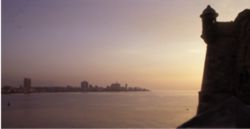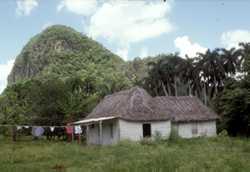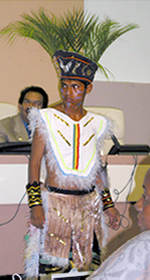ILLUMINATIONS: Cuba's Fate and Ours
PART 1: From Survivor to Savior?
By Philip S. Wenz
July 1, 2003
 click image for a larger view Havana's Malecon (seaside roadway) and hotel district as seen from the old Spanish fort across the harbor.
|
Two weeks after returning to Berkeley from Havana, I phoned one of my closest friends in New Mexico. I had promised to call her before I told too many people about my Cuban experience so she could get the undistilled version. In truth I was, and still am, processing, processing . . . what had I seen and what did it mean?
Since my return, I had already made the accidental acquaintance of several people who overheard me describing Cuba to others. I bumped into a friend while in line at my bank, for example, and expressed my enthusiasm for Cuba, its people and its system. We suddenly found ourselves in a three-way conversation with a stranger behind us who said that her trip to the island had transformed her. Cuba transformed others I met—a new face in my Yoga class; the daughter of some friends who had just returned from a Harvard University program there; others who went with their eyes open and returned with their minds blown.
I explained to my friend in New Mexico that going to Cuba was not like going to Italy, France or Brazil—anywhere else, really.
"It's beautiful," I said, "with its own beauty that rivals any other place I've been—Hawaii, the Grand Canyon, Italy.
 click image for a larger view A "typical" country home in the Pinar Del Rio district where the Global Exchange delegates walked. Note the thatched roof of local grasses and the solar actuated wet laundry processor in the front yard.
|
"But that's only part of it. What really impressed, and somewhat surprised me was the people. They are happy and healthy and balanced and strong. The condition of the people is my test for how well the system works. I can definitely tell you that the system works just fine, that the Revolution, as they call it, that ongoing social and cultural process which is their total expression as a people, is nurturing and strong and far from being on the verge of collapse. All that doomsday stuff you hear outside of Cuba, especially in the US media, is bunk.
"These are not people who hang their heads and drag themselves under gray, Orwellian skies to some sterile office to do the bidding of faceless bureaucrats whom the hate. The Cuban people have dignity and a respect for others and their surroundings that goes hand in hand with self-respect. Everybody, even those who in the US would be considered the lowest of workers, has dignity, because they have never learned that they are "inferior." The whole idea of class is strange to them. The Cubans are functional, connected, social and egalitarian in ways that we in the US can barely understand. Most of them are enthusiastic participants in their collective, life-long, generation-spanning experiment. All will be the first to tell you that the Revolution is not perfect, but it is their Revolution.
"But, you know," I said, the illumination I had been struggling to express since my return finally dawning, "there is something more, much more to my experience than just learning about Cuba. It's coming to grips with what that learning represents. What's true about Cuba is that it offers hope. Cuba is a successful socialist experiment, not a dreary Soviet failure or a Chinese totalitarian ant hill (if we can believe anything we've heard about China).
| There is a saying in Cuba that tonight 20 million children on this planet will miss their dinner and sleep in the streets—and not one of them is Cuban. |
"The hope that Cuba holds for the world, and its "threat" to the US, is that there can be—there is—a society that takes care of its people. It doesn't oppress them, it meets their needs—and in a fairly non-intrusive way. Everyone is fed, clothed, housed, given the best medical care in the world*—these things are guaranteed to every man, woman and child and, two generations after the "Triumph of the Revolution," are taken for granted as a normal and natural part of life. There is a saying in Cuba that tonight 20 million children on this planet will miss their dinner and sleep in the streets—and not one of them is Cuban. Despite a severe US trade embargo, Cuba is doing well."
Before I left for Cuba my hope for the world was . . . diminished. The US is moving in the opposite direction from Cuba's Revolution, doing less and less for its people, concentrating more and more of its wealth in the hands of the rich, rushing at breakneck speed toward oligarchy. If we do not destroy the planet in an single nuclear conflagration, will surely do so through environmental devastation, and soon. We represent four percent of the world's population and consume thirty-five percent of its resources.
I left for Cuba just when it was becoming clear, as I had predicted in an earlier article in ECOTECTURE, that the US would become bogged down for years in Iraq, killing people, being killed; when Pacific island nations were making contingency evacuation plans against rising sea levels caused by global warming; and when there was a bumper crop of SUVs sold at home. The best I could hope for was forestalling the current US administration's disastrous policies and that the good people of America would someday wake up. A reversal of current trends in the direction of sustainable development seemed as distant a dream as Thomas Moore's Utopia. (Or Earnest Callenbach's Ecotopia, a novel that takes place in the independent country of NORTHERN CALIFORNIA after it secedes from the US).
| By the time the special period was over in the late 1990s, Cuba was feeding herself — organically, sustainably, without pesticides or much mechanization. |
If, before I went to Cuba, someone had asked me what I expected to find there, the last thing I would have said was "hope." I wanted to go, initially, because several years ago a student in my Principles of Ecological Design course at the San Francisco Institute of Architecture brought in a movie about Cuba's organic agricultural revolution. When the Soviet Union collapsed in 1989, and Cuba was suddenly left without the support of its "parent" communist country, it was predicted by the world community that the island's populace would starve. Instead, under the steadfast leadership of Fidel Castro who told the Cubans that a "strong and brave" people would never return to "slavery," the Cubans tightened their belts, literally, and entered the "special period," a euphemism for what amounted to an economic depression. By the time the special period was over in the late 1990s, Cuba was feeding herself—organically, sustainably, without pesticides or much mechanization. I was fascinated, and vowed to someday visit the island and see this "green revolution" for myself.

A delegate at the Fourth International Conference on Ecology and Sustainable Development. (Actually, a medical student performing a dance from Peru, his native country, at the Conference's closing ceremony. Cuba trains several hundred foreign medical students from foreign countries for free each year. The only requirement is that, after graduating and becoming doctors, the students return to their native lands and villages and work among the poor for six years.)
|
That opportunity came this year when the San Francisco based NGO Global Exchange organized an educational trip to Cuba which included attendance at the Fourth International Conference on Ecology and Sustainable Development, hosted by the Cuban government, and related field trips to various sustainable development sites. I went to investigate Cuba's sustainable development programs, and this series of articles are a chronicle of that trip.
But to my surprise, I saw much more than solar panels and urban organic gardens. I saw the system that made these things possible and made them available to the people, indeed made them a project of, for and by the people. Cuba's green revolution is an extension of its socialist revolution. One could not exist without the other. Both were born of necessity, arising in separate crucial periods of that former Spanish, American and, economically, Russian colony's quest for its own, self-sufficient identity.
The tenacity of Cuba's social revolution, just now coming to fruition after two generations, has illuminated a path toward independence, socialism and, yes, democracy** for all Latin America. Castro himself has said that violent revolution is a thing of the past. But democratic social change pressed, pressed by the great mass of people will slowly blossom throughout Latin America, in no small measure inspired by Cuba. Whether this change is violent or peaceful will depend more on the United States and its acceptance of the natural course of history than on the Latin people themselves. Obviously they will prefer that their homelands not be ravaged by war, but if they must defend themselves they will. If there is sufficient disclosure to the US public about the nature of their development—rather than a hyped-up media campaign about terrorism and drugs—the Latin nations will be able to build without first destroying.
| The short version of what followed is that Cuba opted for sustainable development as the way out of its crisis and into a promising future. It was that decision that positioned Cuba to be the light not just of the developing world, but, potentially, of all the world. |
What will they build? Born of Cuba's socialist Revolution was its green revolution. In 1987, the World Commission on Environment and Development (also known as the Brundtland Commission after its Norwegian chairman) formalized and promoted the idea of "sustainable development," which term had been bandied about for the previous decade or so, in its famous report "Our Common Future." In 1989, the Soviet Union collapsed and Cuba was at a crossroads. The short version of what followed is that Cuba opted for sustainable development as the way out of its crisis and into a promising future. It was that decision that positioned Cuba to be the light not just of the developing world***, but, potentially, of all the world.
Why such a bold claim? One of the many problems facing ecological designers or promoters of sustainable development is that of non-integrated, piecemeal implementation of solutions—here a solar house, there a campus with a bioremediation pond. But, with the exception of a few private homes and farms belonging to dedicated practitioners, where can we find integrated systems with completed loops wherein the waste product of one process becomes the energizer of the next—systems that mimic natural ecosystems?
|
|
Instead of just writing and |
The entire nation of Cuba is moving, albeit slowly, but at lightening speed compared to most of the rest of the world, toward an integrated, managed sustainable ECO ...logy ...nomy ...culture. It helps that Cuba is an island. It can to some extent be isolated from the problems of other, badly developed or developing countries. (Not, unfortunately, from the effects of global warming, or from all the crap the US is spewing out of the mouth of the Mississippi River into the Caribbean.) It also helps that Cuba has a centralized, socialist government so that integrated planning is possible. By contrast, think of the underlying contradiction of the objectives of the US Department of Housing and Urban Development, Department of Transportation and the Environmental Protection Agency.
Because she sees sustainable development as the key to her future, Cuba has made impressive efforts to educate her people about the interconnections between the ecosystem which supports them and their own welfare and well being. The country has also taken tremendous strides toward building a sustainable system, starting, of course, with the basics—feeding itself with organically grown, pesticide free natural products; reducing its dependency on the monoculture of sugar; developing alternative energy production capacity; eliminating energy waste both through conservation measures and by producing electricity where it is needed, locally and by diverse means, and eliminating line voltage drop and grid disturbances; seriously reforesting—Cuba has doubled its forested area from 14 to 28 percent of its land area in two decades; conserving wetlands and other wildlife reserves; and promoting sustainable and bioregional architecture.
 click image for a larger view The entrance sign at a hatchery for an endangered species of crocodiles near the Zapata wetlands reserve (proximate to the Bay of Pigs) declares that the restoration effort is an "Idea of the Revolution."
|
But beyond all that, and the reason I think that Cuba has a real shot at "getting it together" in a way that could serve as a model for the entire planet, is the potential for developing a nation-wide, integrated system wherein, for example, the waste from the harvest is used to make biofuel (already underway) which in turn is used to drive hammers for rammed earth construction (not yet underway that I saw). The possibility is mind boggling. Instead of just writing and thinking about a sustainable world, we could build one. Cuba's doing it, little Cuba with hardly any money, just grit, intelligence and the will to survive through right livelihood.
Cuba Series
In the upcoming articles in this series I will describe what I saw in Cuba—mostly in the way of sustainable development programs and installations but also, to a lesser extent, the people and their culture—their Revolution—because the two cannot be separated. Our group of 60 or so Global Exchange "delegates" spent several days touring sustainable installations in Havana and, of course, attending the Conference there.
After that, many of us stayed on to join a remarkable individual named John Francis as he walked across part of the island on a mission to promote international peace and understanding (Planetwalk). We walked until our feet hurt, but we also stopped at biosphere nature reserves, solar powered rural schools and medical clinics, a crocodile hatchery, a tiny nature museum and charming rivers and farms. ECOTECTURE invites those of you who could not join our Cuban adventure to join us virtually.
Footnotes
*Cuba's medical system is on a par with those of the US and Europe, technically, but far more advanced in its preventative medicine, the use of natural medications and, of course, universal health care. Cuba has twice as many doctors (not nurse-practitioners, doctors) per capita as does the US. To my knowledge, none of them drive fancy cars or live in big houses or rely on status symbols to convince themselves or others of their relative worth. Like everyone else in Cuba, they make a living—by taking care of people, as it happens. God, the place is refreshing. RETURN to * in article
**The recent international flap over Cuba's arrest of "dissidents," execution of hijackers, etc., has helped create the image of a paranoid dictatorship with no freedom of the press or individual rights. While this picture is far from true, ECOTECTURE is not the appropriate venue for an in-depth discussion of Cuba's complex political situation. I have written an article on the dissidents and have references to many other resources on Cuba's internal politics and international relations. I will gladly make this information available to anyone who sends me an email. RETURN to ** in article
***In its recently adopted constitution, ratified by almost 90% of the voters (the populace, that is, not "representatives"), Venezuela included as a fundamental right that of living in a clean environment. It also made sustainable development a national goal. The extent to which these measures were influenced by Cuba's green revolution is unknown to me at this time, but it seems likely that there is a connection. Further research into Venezuela's sustainable development laws and programs will be undertaken by ECOTECTURE. RETURN to *** in article
. . .
We at ECOTECTURE welcome you feedback. Address
your comments on articles or other matters to editor@ecotecture.com.
If you want them published, put "LETTER TO THE EDITOR" at the top
of the page.
-PSW and the ECOTECTURE Associates